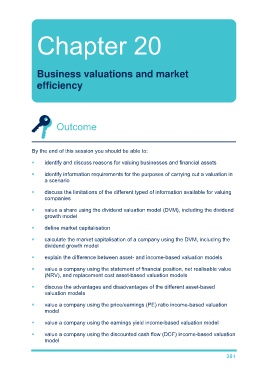Page 389 - Microsoft Word - 00 ACCA F9 IWB prelims 2017.docx
P. 389
Chapter 20
Business valuations and market
efficiency
Outcome
By the end of this session you should be able to:
identify and discuss reasons for valuing businesses and financial assets
identify information requirements for the purposes of carrying out a valuation in
a scenario
discuss the limitations of the different typed of information available for valuing
companies
value a share using the dividend valuation model (DVM), including the dividend
growth model
define market capitalisation
calculate the market capitalisation of a company using the DVM, including the
dividend growth model
explain the difference between asset- and income-based valuation models
value a company using the statement of financial position, net realisable value
(NRV), and replacement cost asset-based valuation models
discuss the advantages and disadvantages of the different asset-based
valuation models
value a company using the price/earnings (PE) ratio income-based valuation
model
value a company using the earnings yield income-based valuation model
value a company using the discounted cash flow (DCF) income-based valuation
model
381

